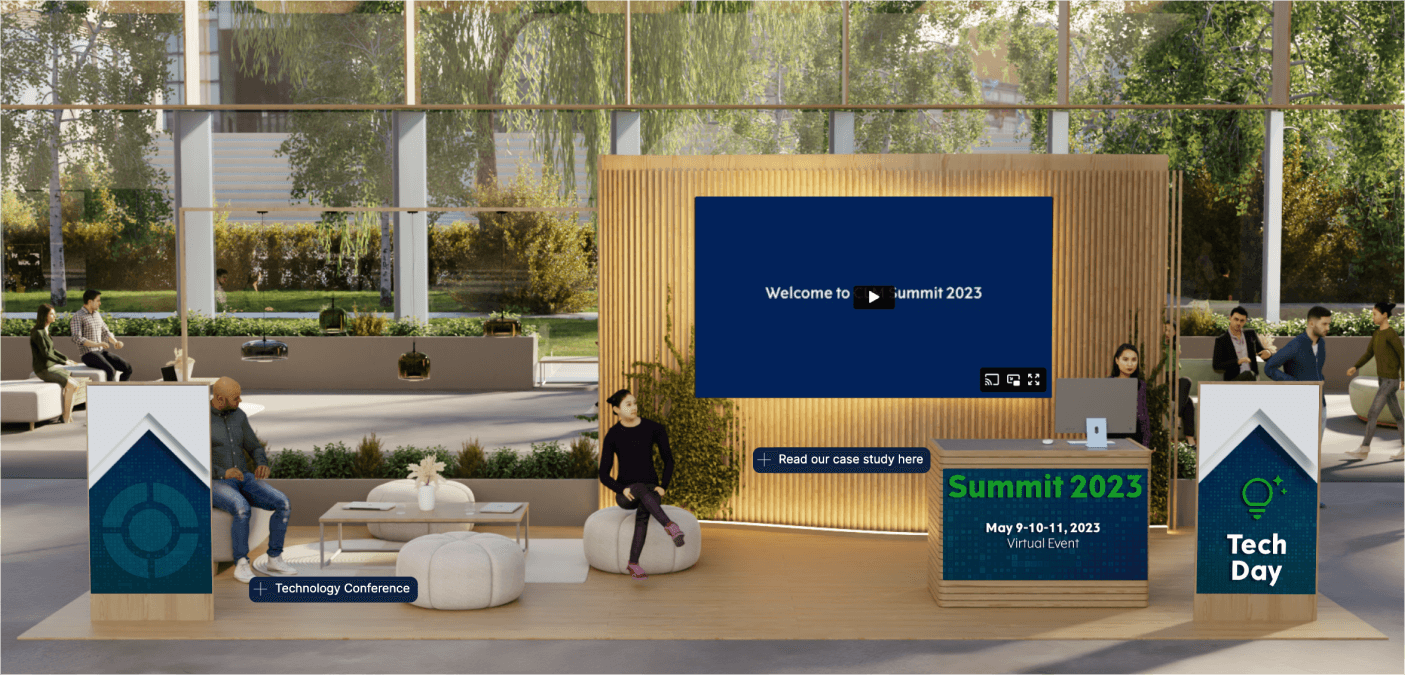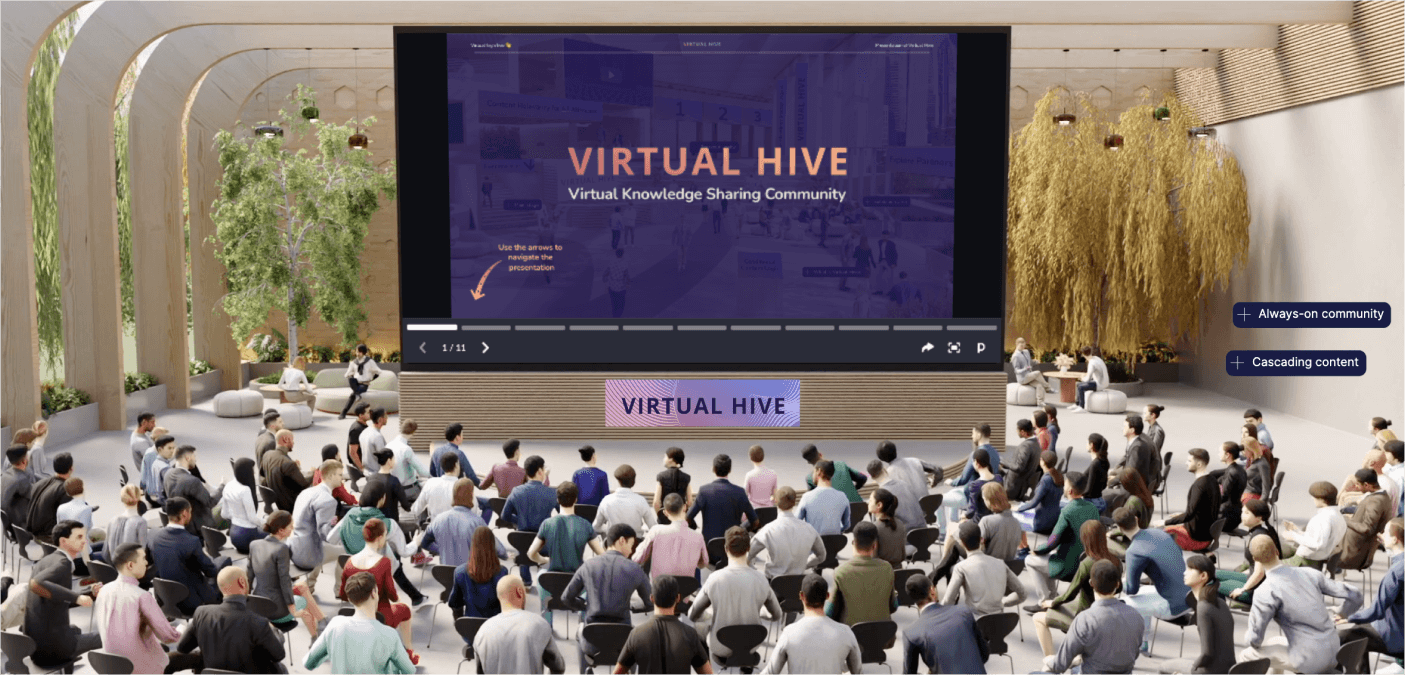
Partner Enablement
Partner enablement refers to the process of equipping and empowering external business partners with the necessary resources, knowledge, and support to effectively promote, sell, and deliver a company's products or services.
It involves providing training, tools, marketing materials, and ongoing assistance to enable partners to maximise their potential and drive mutual business success.
Don't assume existing enablement materials will seamlessly transfer to new (or optimised) partnerships. While some of your sales enablement, onboarding materials, and previous partner content may be applicable, it's crucial to recognise that customisation will likely be necessary to align with the specific needs and dynamics of this partner.
Hosting a partner enablement program in a virtual universe eliminates the need for expensive travel and accommodations, reducing the overall cost of the program.
On top of this, virtual partner enablement can accommodate a large number of business partners from around the world, providing scalability that would be difficult to achieve with traditional face-to-face programs.
For the external business partners, it enables them to fit the program around their schedules and work commitments. Most importantly, virtual partner enablement provides consistency where all partners receive the same information and training, ensuring consistency in messaging and knowledge transfer.
- Problem
- Challenge
- Impact
- Goal
- Benefits
One-Size-Fits-All Doesn't Cut It
All participants in virtual meetings and conferences are presented with the same content despite obvious differences, goals and interests. As such, it is very difficult to maintain an informative, up-to-date and on-brand gateway to all of the business-critical partners, simply because a 'one-size-fits-all' doesn't cut it.
Not Assisting the Audience
This makes it difficult to know if partners, distributors and other sales channels have prioritised, engaged in, and understood your latest sales materials, product launches, and available products. The digital 'contact process' is not scalable nor personalised thus it does not efficiently assist sales channels in finding product information and pinpointing best solutions.
Leaving Money on the Table
This has a negative impact on the business's network of partners, as training tasks become more tedious, communication more intrusive, and the process of ensuring everyone is on the same page more time-consuming, which inevitably has a negative impact on the bottom line.
Sell More, Recommend Better
One single source-of-truth where external business partners, sales channels, and internal stakeholders can see, learn, and engage with relevant product -and sales material, in a time- and cost efficient manner, to train and enable themselves to sell more, recommend better, and knowledge share more effectively.
Know Engagement Paths
Route attendees properly and differentiate content per attendees to make sure engagement rates are in the favourable spectrum. Better guidance and recommendations increases the likelihood of returning audiences. Make everything on-brand and bring the company’s identity to life and showcase banners, logos, and promotional materials, added to fit specific needs. This foster inspiration and connectivity. Know engagement paths by having attendee data and analytics to provide an understanding of the event engagement on a granular level, ultimately giving you the opportunity to make more informed decisions on current and future events.
- 01 Power of Alignment
- 02 Knowledge Empowerment
- 03 Resourceful Support
- 04 Accelerated Onboarding
- 05 Measurable Impact
- 06 Scalable Consistency
- 07 Adaptability to Market Dynamics
Ensuring Clear Expectations
One of the key challenges is the misalignment between business partners and their enablement strategies. Many organisations struggle to define and communicate clear expectations, leading to confusion and inefficiencies in partner relationships.
Equipping Business Partners
Providing Adequate Resources
Streamlining Ramp-up
Establishing Robust Metrics
Consistent Enablement Programs
Staying Agile and Adapting
Answering the Tough Questions
Creating a Roadmap for Success
Approach your partner enablement strategy with the same level of importance as any other training program, whether internal or external.
Consider what your partners require to achieve success and establish metrics to evaluate the partnership's effectiveness. Engage in open communication with your partners to address these crucial questions and ensure a fruitful collaboration.
- Identify key learning metrics (e.g., course completion rates, monthly active learners) and business metrics (e.g., revenue growth, improved retention, higher referral percentage).
- Determine your executive sponsor for the partner enablement program.
- Define learner personas to understand the needs and preferences of your target audience.
- Select the most effective content mediums and delivery methods for your partner enablement... who said 'virtual?'
- Assess ongoing support requirements to ensure continuous learning and development.
- Establish a feedback system to gather valuable insights and improve the enablement program.
- Set an implementation timeline to guide the rollout and execution of the partner enablement initiatives.
Refine Your Partner Strategy
Once your partner enablement program is up and running, it's crucial to engage in feedback sessions with your partners.
Seek to understand if they are receiving the anticipated value and address any pain points or challenges they may be experiencing. Additionally, continuously monitor the KPIs established in the initial phase to ensure alignment with your learning and business objectives.
- Is there alignment between learning teams, the business, and partners regarding KPIs?
- What is the net-new revenue generated through the partnership? What is the recurring revenue?
- Are there identifiable patterns in lost deals? For instance, are specific use cases not being met?
- What feedback are customers providing? Where is the training falling short or not meeting expectations?
- Which topics or courses are most valuable to partners?
- What is the most effective medium for learning (e.g., slides, videos, quizzes)?
- What is the preferred method of content delivery?
- What types of enablement material have your business partners engaged in? Any resemblance? What about the mandatory content?
The Current Challenges
Lack of Alignment: Misalignment between the company and its partners in terms of goals, strategies, and expectations can hinder effective enablement efforts.
Communication Gaps: Insufficient communication and collaboration between the company and partners can lead to misunderstandings, delays, and missed opportunities for enablement.
Training Effectiveness: Ensuring the effectiveness and relevance of training programs can be challenging, especially when catering to diverse partner needs, geographical locations, and varying levels of expertise.
Resource Constraints: Limited resources, including time, budget, and personnel, can impact the scope and scale of partner enablement initiatives, making it difficult to provide comprehensive support.
Content Accessibility: Difficulty accessing and navigating relevant enablement resources, documentation, and tools can hinder partners' ability to quickly find the information they need to effectively engage with customers.
Performance Measurement: Measuring and tracking partner performance, such as sales effectiveness and knowledge retention, can be challenging without robust analytics and reporting mechanisms in place.
Competitive Landscape: Partners may face competition from other companies offering similar products or services, making it essential for the company to differentiate and provide added value through enablement.
Scalability: Scaling partner enablement efforts to accommodate a growing partner network or expanding market presence can pose challenges in terms of consistency, quality, and maintaining personalised support.
Cultural and Language Barriers: Working with partners across different cultures, languages, and regions can introduce communication challenges and require localisation of enablement materials.
Technological Integration: Integrating partner enablement tools, platforms, and systems with existing company infrastructure can be complex, requiring seamless integration and interoperability.

Partner Enablement Re-engineered
Branded screen sharing and website extensions with option to change logo, fonts, and colour palette.
Animated and branded 3D environment where frame of mind and feelings is greatly persuaded.
6 Most Important Partner Enablement Features
Handcrafted features specifically made to enhance enablement to business partners.
Enable effective communication and engagement with diverse audiences, breaking down language barriers and ensuring an inclusive experience for all.
Organise, curate, and deliver relevant and personalised content to the audience, enhancing engagement, and knowledge sharing.
Attendees should be their own editors to increase content relevancy
A content and training universe should be intelligent and always-on
Virtual experiences should be extensions of physical events
Simulated In-person Product Launch
"Bayer's virtual product launch more than doubled the expected attendee numbers, reduced carbon footprint by 67%, and we gained valuable attendee data and analytics – all for a fraction of the price compared to a physical event."

Achieve the benefits
Achieve higher customer loyalty by guiding your members correctly to designated content rooms.
Downgrade on costly TV productions, hotels, and logistics — and switch focus to relevance.
Secure 100% relevance by creating break-outs that fits with interests and needs.
Make informed decisions based on data-driven interest and performance metrics.
No logistics — just a focus on content -and value creation crafted from platform insights.
Guide
partners properly
Guide
partners properly
Make everything on-brand
Make everything on-brand
Start understanding your partners
Start understanding your partners
10 Steps for a Superior Partner Enablement Program
- Emphasise content readability and legibility as a top priority.
- Opt for short-form content over long-form, keeping text to a minimum (in most cases).
- Leverage high-quality videos and images to enhance engagement.
- Personalise the experience by customising elements when feasible.
- Establish a clear hierarchy or learning paths for easy information organisation.
- Incorporate interactive elements like quizzes to make learning enjoyable.
- Group related content together to enhance information retention.
- Insure on-demand access anywhere, anytime.
- Increase recognisability and noticeability with your brand.
- Establish one source-of-truth for alignment and consistent messaging.
A virtual enablement experience solution can effectively achieve these objectives by providing a platform that prioritises content readability and legibility. It allows for the creation and delivery of short-form content, accompanied by high-quality videos and images, which enhances engagement and ensures a personalised experience through customisable elements.
A virtual platform enables the establishment of clear learning paths and interactive elements like quizzes, facilitating easy information organisation and enjoyable learning. By grouping related content together and offering on-demand access, it ensures that learners can access the materials anytime and anywhere. Additionally, a virtual solution incorporates branding elements to increase recognisability and noticeability, while providing a centralised source-of-truth for alignment and consistent messaging.
Facilitating Different Objectives
Powerful Alone.
Unstoppable Together.
Leading companies are beginning to increase content re-use, lower incremental costs, and reduce overall compliance risk.
Empower your partners with immersive training, interactive resources, and real-time communication, fostering a strong partnership and a shared vision for success.
Read MoreElevate training sessions with engaging content, interactive simulations, and performance tracking, equipping your sales teams with the knowledge to drive revenue growth.
Read MoreSeamlessly showcase product features, engage target audiences with captivating content, and gather valuable insights to refine your marketing strategies and elevating your brand.
Read MoreVirtual employee onboarding reduces travel expenses, allows new hires flexibility, and ensures uniform training and communication across the team.
Read More


